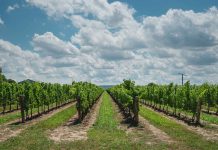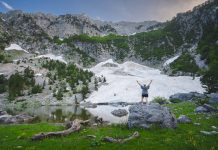Tourism Canmore Kananaskis (TCK) is setting the tone for years to come after launching its most successful marketing campaigns ever, backed by a rebrand and new representation on its board of directors.
The not-for-profit, which serves as the official destination management organization for the region’s tourism industry, announced a rebrand and change to its board of directors at its Nov. 7 annual general meeting, alongside 2021 financials and year-to-date highlights.
New to the board is Kananaskis Improvement District (KID) Coun. Claude Faerden, who represents small business owners on KID council, and a new, vacant seat was also created for an Indigenous delegate.
“We’ve always had a Canmore representative on the board and we felt it was important to invite Kananaskis Improvement District to also have representation,” said TCK CEO Rachel Ludwig of the board change. “This new position will help strengthen our board giving Kananaskis proportionate voice in our governance.”
One of the key themes to emerge when TCK surveyed the public and stakeholders while creating its 2019-2029 strategic plan was the need to work with regional partners including Banff, Calgary, Stoney Nakoda First Nation, Alberta Parks, KID and the MD of Bighorn to reach complementary objectives.
“We see synergies in having a membership at this table,” said Faerden. “Our municipality’s name has been on the brand and identity of TCK for several years and this group has supported our business communities with its operations.
“Now we have representation – an elected official on the board, and I think that’s a really meaningful change to better connect our communities.”
An area of focus for Faerden will be to draw attention to the business community along Highway 40 – an area he says does not get as much attention as it deserves versus the number of visitors to the area.
“This is just one of the things we have been trying to improve, is to get more visibility to the needs of our community,” he said.
Including an Indigenous voice on TCK’s board is also an important part of enacting meaningful change, Ludwig explained. But there is no pressure on any one particular First Nations individual or group to come forward to fill the role.
“We’ve had representation from our members at Stoney Nakoda Resort and Casino for about a year now,” she said. “But we felt it was important to go further than that.
“The seat is really an open invitation to our Indigenous neighbours to get engaged if and when they choose to.”
The previous board included representatives from the hospitality industry, Town of Canmore, as well as a legal advisor, activity provider, financial advisor and retail provider. The Town of Canmore previously held two seats and now holds one as per the new board structure.
Also announced at the AGM was TCK’s rebranding, addressing focus areas like sustainable growth, environment, and Indigenous relations. The rebrand was a high priority goal in TCK’s strategic plan and was approved by the TCK board in 2018, only to be held off by the COVID-19 pandemic.
The not-for-profit shaped the rebrand using resident and visitor research conducted in 2021 and 2022 – including a regenerative tourism framework endorsed by the Town of Canmore in 2021, and survey responses collected from residents and visitors of Canmore and Kananaskis from June 14 to July 16, 2022.
“I really feel that the purpose we have to transform the way we live in the world is one our community can get behind, because people have told us they’re passionate about the environment and sustainability, and Indigenous relations,” Ludwig said. “I really feel these commitments we’re making will serve as a rallying cry for the community as well.”
According to the summer survey which collected 84 responses, about 21 per cent of respondents were from Calgary, 17 per cent were from international destinations outside of the U.S., 17 per cent were from elsewhere in Canada, 14 per cent from the U.S., 11 per cent from elsewhere in Alberta, seven per cent from Edmonton, four per cent from B.C. and 10 per cent did not disclose where they were visiting from.
Half the survey responses were collected in Kananaskis Country, 40 per cent in Canmore, and 10 per cent at a visitor information centre.
This year is the first in which TCK was been able to carry out a full, year-long marketing campaign without any restrictions or holding back spending since its inception in 2018. Year-to-date, the non-profit’s marketing spend is about $725,000, more than double that in 2019.
Last year, they spent $926,000 on advertising and promotional initiatives, assisted by government grant contributions and subsidies totalling $1.236 million – all but $109,000 of which was supplemented from Travel Alberta for mainly operational and some event costs.
“We worked very closely with Travel Alberta in regard to marketing and we are using the same agency as they are, applying some of the same learnings and using our learnings to really target the curious, adventurous people that we know really enjoy Canmore and Kananaskis and fit well with our residents and community,” said Ludwig.
Last year, Travel Alberta invested in 249 tourism projects across all programs. According to a Sept. 27 press release, 15 tourism businesses saw a total of $1.218 million in direct revenue growth since receiving product development investment in 2021.
“While broader data collection is still underway, these strong early results show that Alberta’s tourism industry is on track with 2019 (pre-pandemic) levels,” states the Travel Alberta press release.
Tourism was also stressed as a key component of Alberta’s 2021 budget, which announced an ambitious plan to double tourism spending to $20 billion by 2030.
Results from TCK’s marketing efforts this year show the number of visits to the organization’s website was about 1.1 million, as of Nov. 7, a 179 per cent increase from the same time period last year and triple the amount in 2019. Social media follows also saw a boost of about 28 per cent over the same time in 2021 and marketing efforts have so far helped to drive about 3,500 regional hotel rooms bookings via the travel agency Expedia.
“Of course, the opening of the U.S.-Canada border for those who were vaccinated and then when there were no restrictions also played a role with more people able to travel, so that really helped support our marketing efforts as well as our recovery from COVID-19,” said Ludwig.
In 2021, TCK ended the year with assets of nearly $1.92 million, an increase of over $1.02 million from $898,000 in 2020, and up $1.35 million from $566,000 in 2019. Net assets were $1.61 million at the end of 2021, while 2020 ended with $820,000.
Another $659,000 in revenue was collected from destination marketing fees in 2021, up from nearly $447,000 in 2020, and most of the remaining revenue – about $263,000 – was from the visitor centre and marketing buy-in.
For expenses in 2021, $926,000 went into marketing, which is nearly triple the amount spent in 2020 at $329,000. About $244,000 went to salaries and wages, up from about $169,000 in 2020, and $206,000 went to visitor experience initiatives, up slightly from nearly $200,000 in 2020.
Making up the remainder of the expenses was administrative costs such as travel and accommodation, board and AGM meetings, rent, licenses and dues, and professional and trustee fees, totalling about $80,000.
By 2029, TCK wants to become a leader in sustainable tourism by taking meaningful action on climate change, as outlined in its strategic plan.
Ludwig said there are some exciting initiatives on the horizon to help meet this ambitious target.
“In the coming year, we will be launching a sustainable destination benchmark on where we are today and where we can improve upon to become a leader in sustainable tourism in the future,” she said.
Upon the assessment’s completion around March 2023, TCK will be able to more clearly identify and work toward advancing its sustainability goals.
A learning tool called the Peaks Academy will also be launched around the same time, inviting frontline workers in the tourism industry as well as residents to learn about topics such as sustainable travel, human-wildlife interaction and Indigenous relations, in order to hopefully better transform the Canmore-Kananaskis experience for themselves and visitors.










